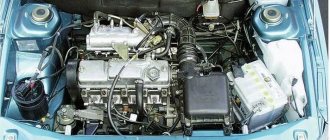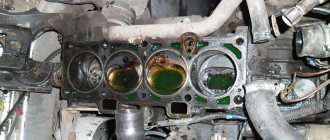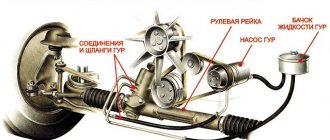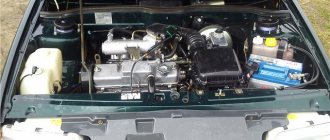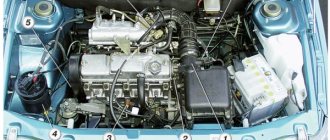The cooling system of domestic cars is often far from ideal. Unfortunately, this system has many shortcomings.
What causes VAZ engine overheating? One of the main reasons remains the human factor, but more on that later. For now, let's look at the many other causes of this problem. The cooling system itself consists of large and small circles through which coolant, that is, antifreeze, moves. When the engine does not warm up, the antifreeze moves in a small circle, and when it warms up, the thermostat opens, which passes the liquid in a large circle through the cooling radiator. Most often, the thermostat simply does not open, and because of this, the antifreeze forms a small circle and does not pass through the radiator. The figure below shows a VAZ 2109, 21099, 2108 thermostat.
To check if the thermostat is working, you need to warm up the engine to a temperature of about 90 ° C and feel the hose going to the radiator. If the tube does not heat up, the thermostat does not work. I don’t know why, but I often encounter this problem in the Lada Samara model range. If you're at home, it's easier to buy a thermostat. Its average price ranges from 250-400 rubles. To replace the thermostat, you must first drain the antifreeze (by opening the expansion tank cap), then loosen the clamps and remove the pipes. Before installing a new thermostat, you must clean the old sealant from all pipes and apply a thin layer of new sealant to the thermostat. Let the sealant dry a little and apply to the pipes. Be careful not to overuse the sealant, otherwise it may come off and clog the radiator. If your thermostat breaks on the way, but you need to get to the village, in a very last resort you can fix the thermostat in a slightly “barbaric” way. You need to remove it and use a screwdriver to open the valve in the hose going to the radiator. Then reassemble. After this procedure, your thermostat will not work as the large circle will always be open. But it will be enough for you to get to the nearest store.
Prices in online stores:
| Car alarm Pandora DXL 5000 S | I catch | 45400 rub. |
| Anti-theft and security systems Hood lock Starline Electromech L11 | NORD24 – Ekaterinburg | 3780 rub. |
| Security and search module X-Keeper Invis DUOS | Kotophoto | 6500 rub. |
| Signal systems Elect SU-400 Extra Vepr Timing N | viva-telecom.org | 31200 rub. |
| Signaling systems Elect SU-100-1 Vepr | viva-telecom.org | 12900 rub. |
| Electric alarm system SU-100-1 Vepr GP | viva-telecom.org | 12900 rub. |
| Other offers |
Sometimes on models starting from the VAZ 2108 the cooling fan activation sensor does not work. On previous models there is no such problem, because there is no such sensor; the fan is powered by the motor. The sensor itself is located on the side of the radiator and looks like this:
There are 2 wires coming out of it. If they are closed, the cooling fan starts. If your thermostat is working and the radiator is all very hot (everything is very hot, that is, more than 95 ° C), then most likely this sensor is faulty. You can get to the repair site by short-circuiting 2 identical wires (there is nothing wrong with that). If shorting the wires does not help, check the fuses.
Another common cause of overheating is the so-called “gateway”. The gateway is a layer of air remaining in the radiator due to the difference in the densities of antifreeze and air; it is located in one place and prevents antifreeze from moving through the pipes. I wrote above that the entire radiator should be hot. If it's not really hot, there's probably an airlock there. You can remove the layer of air by pressing (as if you were pumping) the top tube going to the radiator. The same thing, but with all the hoses that need to be done after adding antifreeze. It is necessary to pump it until bubbles stop appearing in the expansion tank. Another reason for VAZ engine overheating is a coolant leak. If a pipe leaks along the way, you can wrap it with duct tape or duct tape to get it to the nearest auto repair shop. If the radiator or thermostat is leaking, it's best to simply add coolant and continue driving, checking the temperature and fluid level. Do not pour cold water into a hot engine.
When the engine starts to boil, never turn it off immediately. On small ones, you need to let it work, while turning on the internal heating to maximum, so that the liquid also cools through the heater radiator. It can only be switched off immediately if there is a loss of coolant.
If the car overheats and throws out the antifreeze, at best it would be a good idea to replace the head gasket. In the worst case, piston. But God forbid you remember about the cooling system only when the time comes to change the antifreeze!
The car engine is warming up.
Overheating of a car engine is a problem that any motorist can face. In this article we will learn: – how to notice in time that the engine is overheated; – why the engine overheats in general and in certain situations; – what to do if the engine overheats.
To understand the essence of the problem, you need to read all the explanations of an experienced mechanic one by one.
How to determine if the engine is overheated
At first glance, it looks very simple - according to the indicators of the engine temperature device, or - sensor. This is true, if not for one circumstance - novice motorists are so captivated by the road situation that they look at the dashboard only in one case - how much fuel is left. Even experienced motorists, on the contrary, due to self-confidence, do not look at the car’s dashboard. As a result, a situation often arises where overheating is detected when the engine temperature has been above the permissible limits for a long time and irreparable damage has been caused to the engine. This irreparable overheating is one of the most severe malfunctions, which leads to very serious consequences. But we'll talk about this later. But there is a way that will not make you miss the moment of overheating. This is problematic in traffic and is not always clearly present, but you should be aware of it:
Breakdowns
The most popular and common breakdowns of DTOZH include:
- Lack of contact with the sensor;
- Break of contact, insulation disappears;
- The device stops working;
- The fan does not turn on when required.
It is also important to examine the signs of trouble. These include:
- The engine has not yet warmed up, but the fan is already starting to work;
- The engine has warmed up, but still does not work properly;
- Fuel consumption has increased significantly.
One of the common mistakes made by beginners is that they often confuse the coolant temperature indicator sensor with the coolant temperature indicator.
Warming up the car is pointless and harmful
Times are different now, but the car still needs to warm up a little (this is my personal opinion). The physics is not erased: at low temperatures, the oil becomes more viscous. The oil pumpability through the system is reduced, so the engine has to operate in a lack of lubrication. First of all, cylinders, pistons, bearings and other parts suffer from this. Insufficient oil film thickness leads to metal-to-metal friction in parts, causing accelerated wear. This also applies to transmissions, especially automatic ones, since gear oils also become more viscous in sub-zero temperatures (you can read more about this here). Right now, let's be honest.
Do you drown your car in winter?
Open to: everyone, detailed results available to: everyone. Participants: 388
Do you drown your car in winter?
Sometimes (if there is time) 81 (21.0%)
Reasons that can cause overheating
1. Lack of refrigerant. The liquid in the engine boils not because there is not enough of it, but here’s why: remember the outer surface for cooling? In the absence of fluid, the contact surface between the fluid and the heated engine is insufficient, and heat transfer to the environment is poor. Hence the overheating. The engine cooling system is not sealed, as many people believe, and during operation the liquid evaporates - do not forget to check its level regularly. And, of course, monitor the condition of the radiator and pipes - leaks are unacceptable. There are cases of internal leaks - due to damage to the gasket between the cylinder head and the cylinder block. Water does not flow from the drain hose, but a constant decrease in the liquid level without visible leaks is a reason to exercise caution and contact a specialist. Water that accumulates in the cylinders when the engine is started can cause water hammer - this can literally destroy the piston assembly and much more.
2. Radiator condition. The gaps between the radiator ridges are quite small and can gradually become contaminated by representatives of the insect world. It's no joke, there was a case when a slight contamination of the radiator (coupled with the poor condition of the engine) led to constant overheating of the car. Keep the radiator clean and at least blow it out with compressed air from time to time.
3. The opening angle is incorrectly set. If the ignition angle is violated, the fuel combustion process stops. As a result: an increase in combustion temperature and a decrease in power. The power has decreased, but this is not necessary. What are we doing? That's right: press the accelerator pedal harder. It turns out that more fuel is spent on the design operating mode of the engine (where normal cooling occurs). Hence the overheating. By the way, a problem with ignition may arise (it is spontaneous, and not after your intervention in the finely tuned engine mechanism) if the timing belt or chain is extended. This is not the only option, but it is common - keep that in mind.
4. Fuel quality. An inappropriate octane number leads to a decrease in power and an increase in the temperature of fuel combustion. There is only one way out - to refuel in one place, so the likelihood of getting low-quality gasoline is lower.
5. Deposits on the walls of the engine and radiator. The reason is simple - the use of low-quality coolant or even water. A little more detail. From a physical point of view, it is better to use water, since water has better thermal conductivity than alcohol-based antifreeze. But - there are salts in the water (this can be observed on the walls of the kettle) - this also happens inside the engine. As a result, water circulation is disrupted, cooling efficiency is reduced and the engine overheats. If you are already pouring water into the expansion tank, pour distilled water, it does not contain salt. And it is better to use special antifreeze. Believe me, it is impossible to completely remove the ladder from the engine. And one more “beauty of water”: if after water, for example, for winter you add antifreeze, get ready for drops (it can flow everywhere: radiator, pipes) - this is a fact. Constantly drive “on antifreeze”, nothing will happen, but after water, antifreeze will flow to 99%.
Reasons for long engine warm-up
- The ambient temperature is too low and, as a result, the coolant temperature in the radiator is too low. The easiest way out of this situation is to insulate the radiator, engine compartment, hood and engine. Ordinary plywood or cardboard inserted in front of the radiator very quickly and effectively solves the problem of engine cooling while driving. As for the car blanket and hood insulation, with this solution a cold engine will warm up faster and reach operating temperatures.
- Thermostat is not working properly. For those who do not know or simply forgot, it is worth recalling that this part is responsible for directing the flow of coolant along the large or small cooling circle. The small circle prevents antifreeze or antifreeze from entering the radiator and ensures its circulation only inside the engine. As a result, the motor heats up faster.
Only after heating the liquid to a certain temperature does the thermostat work and release antifreeze through the radiator for better cooling. In turn, antifreeze not only performs the function of cooling the engine during operation, but also maintains the set operating temperature of the unit.
A constantly open thermostat prevents antifreeze from reaching the required temperature in winter. This is why the engine takes a long time to warm up at this time of year. Solution: repair or replace the thermostat.
- Air lock in the cooling system. As with any heating system, air interferes with the normal passage of fluid. In this case, it is necessary to determine the cause of the traffic jam and eliminate it.
We also recommend reading the article about why the engine does not warm up to operating temperature. From this article you will learn about the main reasons why the power unit warms up, but the heating is insufficient.
- A less common cause of long warm-up may be a feature of the factory settings of the car’s electronic control unit (firmware) or their incorrect settings during flashing (chip tuning). One of the easiest solutions is to install an additional on-board computer with a function for adjusting the fan temperature.
- Premature operation of the cooling system fan can also lead to long warm-up times. It happens that the specified fan turns on even after starting a cold engine.
VAZ 2115 does not heat up to operating temperature
The heater and cooling radiator is leaking. I bought new ones, installed them, and at the same time replaced all the pipes, thermostat, and heating valve. I filled it with antifreeze, started it, the flow stopped, but now the temperature does not exceed 85 and barely warm air is blowing, the pipes leading to the stove are hot. Before replacing, it warmed up to 92 and the air was hot. VAZ 2114, 2007
- How to replace the pipe from the stove to the head on a VAZ 2115? – 4 answers
- Idle cold air from the stove, VAZ 2115 – Stack overflow in Russian
- How to remove the stove on a VAZ 2114? – 2 answers
- The VAZ 2114 stove does not work - 3 answers
- I tore off the hose from the radiator on a VAZ 2109 – Stack overflow in Russian
Well, with the temperature everything is clear - a new thermostat was apparently installed with the same opening temperature. The air should blow hot even at 80 degrees. Apparently there is something wrong with the shock absorbers on your stove. Or, after all, there is an air lock in the heater radiator (with a working cooling system, it will sell itself, sometimes not the first, but the second day). Is there enough coolant in the expansion tank? After such work on replacing the coolant, it is necessary to monitor the level for the first few days and top it up - the air caps are blown out.
Well, even if 85 heats up, it should already warm up normally. The heater core can easily be of poor quality. Those parts are now dripping. Is the thermostat the same as before? The thermostat may also be faulty. So something like that.
The thermostat needed to be boiled before being installed in a pot of water. See at what temperature it opens. And most likely there is air in the stove.
Subscribe
to our channel in I ndex.Dzene
What to do if your car overheats in a traffic jam
When driving a car for a long time in a lower gear, the engine operates with increased power, which in itself leads to overheating. To this should be added the lack of counterflow of air necessary to cool the radiator. What to do? The main thing is not to panic. Brief overheating is not a big deal, but if you see that the car is not cooling down, it’s time to act.
Important: do not turn off the engine unless absolutely necessary. That's right - no extremes. A stalled and overheated engine is an almost 100% guarantee of repair. It will take a long time to describe what is happening in the engine in this case (rotating the liners along with the crankshaft, the next time you start the engine - the least possible problem), take it on faith.
Important: Do not attempt to pour water on the engine or pour cold water into the radiator. There is only one result: repair. Additionally, you may be working so hard that you can't help but replace the block and cylinder head. Another “charm” of cold water is microcracks inside the block. Finding and fixing it will be very, very difficult, if not impossible. The car is overheated, try stopping. If it doesn't work, don't panic and don't pay attention to others, it's important to preserve the engine. We stopped at idle, turned the heater on full blast and waited. If the situation does not improve after 5-10 minutes, turn off the engine. It’s a good idea to open the hood; the main thing is not to forget to put the parking brake on the car in a panic.
The only reason to stop the engine immediately is if there is a puff of steam coming from under the hood. Most likely, the cooling pipe has burst, and further operation of the engine will only worsen the situation.
So, the engine overheats, if you look closely. Now you know why the engine overheats and how to deal with it. Author: Igor
Normal engine temperature
For all previously produced cars (since 1992), the normal operating temperature of the engine was 90 degrees C. This value was generally accepted not only for Russia, but for the whole World, and all automakers were based on it in their standards. With the further development of automotive technology, it became clear that it is not always possible to adhere to the specified figure (especially due to the variety of engines and their systems).
As a result, at the newly held international congress, it was determined that the standard operating temperature for gasoline engines of all types will henceforth be considered the range from +85 C to +105 C. Any engine temperature within these limits is considered normal, but any, even small exceeding it to a greater extent is already overheating.
If we talk about Lada cars, including the 14th model, then the normal operating range will be a temperature from +87 to +103 C. This interval is the most optimal both in terms of performance and engine load.
If the temperature in the engine drops below the specified norm, the car will lose power and acceleration dynamics. If the temperature goes beyond the upper limits, the engine can boil and suffer significant damage (long-term driving with a boiling engine can threaten not only its serious damage, but also wear and tear on the units adjacent to it).
injector - how fuel injection systems work
A fuel injector is nothing more than an electronically controlled valve. It comes with the pressurized fuel pump in your car and can open and close many times per second.
| Inside the fuel injector |
When the injector is energized, an electromagnet moves a piston, which opens a valve, allowing pressurized fuel to flow through a tiny nozzle. The injector is designed to atomize the fuel to create as little mist as possible so it can burn easily.
| Fuel burner |
The amount of fuel supplied to the engine depends on how long the fuel injector is open. This is called pulse width and is controlled by the ECU.
| Fuel injectors installed in the engine intake manifold |
The injectors are mounted in the intake manifold so that fuel is sprayed directly onto the intake valves. The tube, the fuel rail, supplies fuel under pressure to all the injectors.
| In this photo you can see three injectors. The fuel rail is the tube on the left. |
The engine control unit is equipped with many sensors to ensure the correct amount of fuel is supplied. Let's look at some of them.
,
Thermostat malfunction
The thermostat is one of the weak points of the VAZ. It is located on the right side of the cylinder block in front of the vehicle. To check the thermostat, you need to heat the car to the ignition temperature of the fan and touch the lower radiator hose with your hand. If the thermostat is working, it should be hot.
Removing the thermostat on a VAZ 2114
A cold pipe indicates that the thermostat is stuck in the closed position. In this case, the coolant circulates around the radiator in a small circle. Heat exchange is disrupted: the engine quickly overheats. The problem is solved by replacing the thermostat.
see also
- Tiguan 2022 r line in Russia
- Shots into the silencer when pressing the gas
- Inheriting a car
- How to check the electrolyte density in a battery
Vibration stand for Mercedes suspension diagnostics- Four-digit license plates on cars
- Priora cooling fan does not work
- Truck maintenance
Generator for VAZ 2110 injector repair- White smoke from the exhaust pipe of a gasoline engine
- Replacing the thermostat with
Why does the engine on a VAZ-2114 get hot?
Excessive coolant temperature causes engine failure
The main culprits for excessively high coolant temperatures are:
- The thermostat is faulty (see “Replacing the thermostat on a VAZ-2114 with your own hands)”;
- inoperative cooling fan or faulty wiring;
- the valve is stuck in the expansion tank cap;
- temperature sensor (DTOZH);
- excessively dirty radiator. Either the honeycomb or the radiator is clogged inside (the only option is to replace it with a new one)
All of the above components and parts significantly affect the operation of the cooling system and, in the event of a malfunction, contribute to an increase in engine temperature above normal. Each part of this system can be checked independently and, if a malfunction is detected, it can be eliminated.
Diagnostics and elimination of overheating
Troubleshooting should be broken down into steps and started in the following order:
- Expansion tank cap. In its design, it has a built-in valve that ensures the creation of the necessary pressure in the system. If it breaks, the antifreeze will boil in the expansion tank.
Often this valve gets stuck in the open or closed position.
An open position will make it impossible to create pressure, while the liquid will not circulate normally and will begin to overheat. On the other hand, the closed position will not allow the resulting gases to leave the system and create excess pressure at which the engine will boil. To check, just unscrew the cap and look at its internal condition; if there are traces of scale and other contaminants, the part is replaced with a new one.
Check for contamination of the expansion tank cap
If the fan detects a delay in turning on or does not turn on, the temperature sensor must be urgently replaced.
Change the coolant temperature sensor
We carry out a visual inspection of the cooling fan
We inspect the radiator, if necessary, disassemble and clean the honeycombs
Symptoms of overheating
The temperature arrow tends to the red zone - soon overheating
A fully warmed-up engine has an operating temperature in the range from 92 to 102 ° C , exceeding which can cause big trouble. Its condition is monitored by a sensor that turns on the cooling fan. The fan turns on on the stock firmware at a temperature of 102 °C .
The first symptom of engine overheating is the reading on the instrument panel; in this case, its needle approaches the red indicator.
Steam from under the hood
Steam from under the hood
If steam appears from under the hood, this indicates an increased temperature of the coolant of the power unit.
Strongly heated antifreeze splashes out of the expansion tank cap and hits the hot engine elements, which is why steam is formed. In this case, wet traces will form under the car, which have a characteristic smell of coolant.
Squeezes antifreeze out of the expansion tank
If these symptoms appear, you should immediately stop using the car and start looking for symptoms of overheating , otherwise the engine may fail, which will lead to an expensive overhaul.
Radiator clogged
The radiator can become clogged from the outside and inside. External contamination is associated with dust and other debris entering the honeycombs, as well as insects. This impairs heat transfer and manifests itself in frequent fan operation and prolonged operation.
Engine cooling radiator clogged with honeycombs
A good rinse with a pressure washer solves the problem. If the radiator has been running for a long time, the car cools down and heats up worse due to deformation of the honeycomb. This problem can be “solved” by replacing the radiator.
The radiator rarely clogs from the inside. This usually occurs due to poor quality antifreeze, driving through water, or as a “side effect” of radiator sealants. The presence of this problem is indicated by the coolant - it becomes cloudy, oil stains and solid particles are visible. The cooling system of the VAZ 2114 is washed by completely draining the antifreeze with distilled water with the addition of radiator cleaners.
According to statistics, three-quarters of the answers to the question of why the engine in the “four” overheats are associated with one of the above-mentioned malfunctions. They can be diagnosed and fixed independently, without resorting to the services of a car service. If none of these methods solves the problem, it is better to contact a specialist for diagnosis.
Other reasons for overheating of the VAZ-2114:
- Leaking cylinder head gasket (cylinder head gasket).
- pump malfunction;
- dashboard malfunction;
Dashboard malfunction
The reason for incorrect readings on the instrument panel may be a manufacturing defect or a huge number of failures in the electrical network: from a small weight on the ECU to a failure of the voltage stabilizer (“pill”). This may be indicated by erratic changes in temperature readings (jumps), erroneous readings from other devices, or a discrepancy between the fan turning on and the temperature readings.
This malfunction is less problematic: the machine does not really heat up, but only for the computer. But this also reveals other problems that need to be solved.
Leaking cylinder head gasket
This problem is one of the rarest causes of engine overheating on VAZ 2114 cars. When it occurs, overheating is already a secondary symptom that can accompany many others:
- increased oil burn, noisy engine and gas operation, black exhaust.
- unstable engine operation and low compression;
- oil leak from under the cylinder head;
In such a situation, the best solution would be to replace the cylinder head gasket. In the worst case, overhaul the engine with cleaning of all internal cooling channels.
When the engine warms up, it is dangerous not in itself, but because of the consequences. Long-term driving at high operating temperatures primarily leads to the loss of properties of elastic parts: valve seals and piston rings. This increases oil consumption and makes the engine rough and dirty. All of this requires expensive fixes.
The consequences of severe overheating are even more serious: the cylinder head and cylinder block are deformed and sometimes crack. Such an engine that survives cannot be repaired.
Consideration of the issue of engine warming up from a theoretical point of view
The components of our engine, namely pistons and rings, are most often made of aluminum, steel alloys and cast iron. You've probably heard the term "engine seized" before, but haven't given it much meaning. The engine seizes when, due to overheating, the aluminum pistons expand and rub against the cylinder walls, when there should be a certain gap between them. In an engine that is not warmed up, this gap is very large, which leads to low thrust.
When we start a cold engine, cold air with a high oxygen content enters the combustion chamber, and gasoline is supplied in the same amount. Mixing these two components results in a lean mixture. In a carburetor system, a choke will help cure this deficiency, which will increase engine speed, and the injection system will automatically balance the mixture, which will also increase the number of engine speeds.
Also, do not forget that cold oil has a higher viscosity, as a result of which a greater load is placed on the engine.
